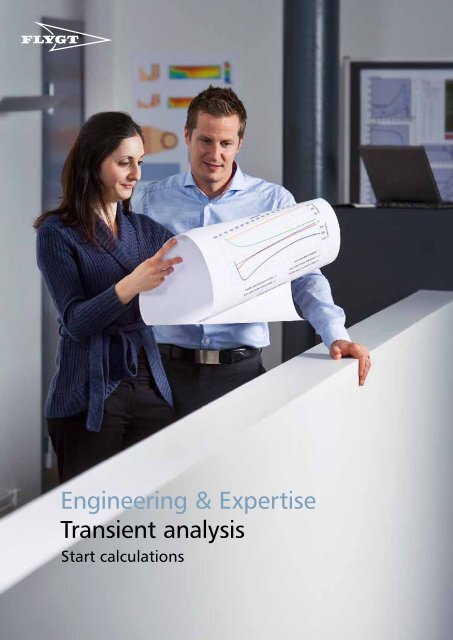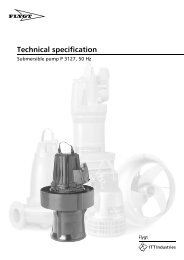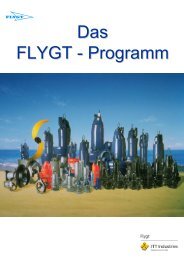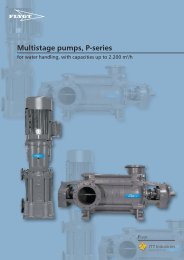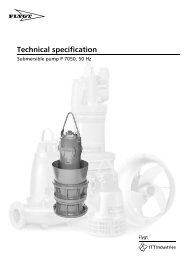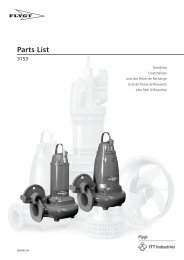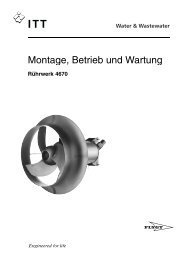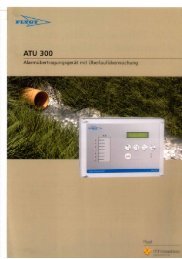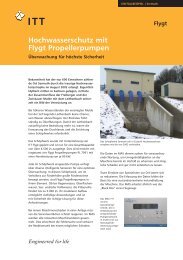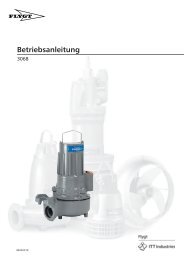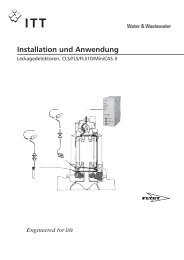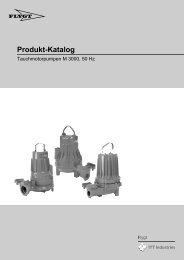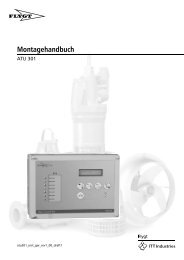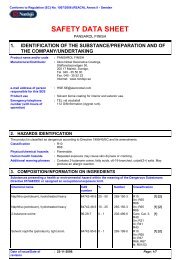calculations - Flygt
calculations - Flygt
calculations - Flygt
You also want an ePaper? Increase the reach of your titles
YUMPU automatically turns print PDFs into web optimized ePapers that Google loves.
Engineering & Expertise<br />
Transient analysis<br />
Start <strong>calculations</strong>
EnginEEring & ExpErtisE<br />
Total solution engineering<br />
increases operational efficiency<br />
2<br />
Introduction<br />
Being able to predict the performance of a<br />
pump during its startup cycle has distinct<br />
advantages. Among them are more reliable<br />
starts, optimal startup torque and minimal<br />
risk of motor overload. It is therefore considered<br />
good engineering practice to analyze<br />
the pump system’s starting cycle. By performing<br />
start <strong>calculations</strong> using an accurate<br />
mathematical model of the system, we determine<br />
optimal system pressures and flow<br />
rates at startup.<br />
performing such theoretical analysis on pump<br />
systems requires engineering and expertise. We<br />
will provide guidance for optimizing pump starting<br />
cycles using our system expertise and product<br />
knowledge to conduct thorough theoretical analysis<br />
of the pump systems using specially developed<br />
engineering software.<br />
Theoretical analysis<br />
Products<br />
Physical tests<br />
Reference installations<br />
Engineering & Expertise<br />
Achieving lowest total cost of ownership<br />
When providing pumping solutions, <strong>Flygt</strong> prefers to take<br />
the total cost of ownership into consideration.<br />
Unplanned<br />
Investment<br />
Operational<br />
� Investment costs<br />
Costs associated with design, excavation, civil work,<br />
product purchases, installation and commissioning.<br />
� Operational costs<br />
Over time, energy usage and maintenance costs are<br />
often the major contributors to the overall costs along<br />
with the cost of labor required to run the system.<br />
� Unplanned costs<br />
When things go wrong, such as pump failures stemming<br />
from problematic station design, costs can sky rocket.<br />
Unexpected downtime can cause sewer backups, overflows,<br />
basement flooding and untreated effluent. On<br />
top of that, you have to repair pumps and take corrective<br />
measures regarding the station design.<br />
Engineering & Expertise<br />
thanks to our engineering expertise, we can lower your<br />
total cost of ownership. We can analyze your system<br />
using state-of-the-art computational programs. We can<br />
test your pump station using scale models if required.<br />
We can also provide you with reference installations<br />
that are similar to your project. All of this together with<br />
our premium products provides you with an optimized<br />
design.
Start <strong>calculations</strong>:<br />
Hydraulic transient analysis<br />
When dimensioning and designing a pump system, it is<br />
important to analyze the influence of the starting conditions<br />
on the pump system during transient operation.<br />
transient operation is the period of time between two<br />
steady state conditions; in this case, the time period between<br />
pump at rest and pump in operation.<br />
When starting the pumps there are three different<br />
characteristics that should be evaluated: motor torque<br />
and power, magnitude of the starting current and hydraulic<br />
analysis of filling the pipes.<br />
Motor torque and power<br />
Analyzing the motor torque is important to make sure<br />
that the pump has sufficient motor torque to accelerate<br />
the fluid at startup. problems may be encountered, for<br />
example, when starting a propeller pump in a system<br />
with check valve, such as a pipe system filled with<br />
water. therefore when designing a filled system with<br />
propeller pumps, it is highly recommended that a start<br />
calculation be performed.<br />
the motor of the pump can experience overload during<br />
startup. Centrifugal pumps are sensitive to startup when<br />
the system is empty. propeller pumps are sensitive to<br />
startup when the pipe system is filled. When designing<br />
a system that is not preferred for the pump type, a start<br />
calculation should be performed.<br />
Hydraulic analysis of<br />
filling the pipes<br />
in some systems, it is essential<br />
to know how the<br />
pipes are filled at startup.<br />
A start calculation provides<br />
a good indication<br />
of how the pipes will be<br />
filled.<br />
Magnitude of starting<br />
current<br />
the typical starting current<br />
is about six times<br />
the rated current. A high<br />
intrOdUCtiOn<br />
Filled system with propeller<br />
pumps.<br />
starting current will affect weak power grids and the<br />
dimensioning of the installed fuse. High starting currents<br />
could be reduced through the use of different<br />
types of start equipment: star-delta starters, soft starters<br />
and variable frequency drives (VFds). When using<br />
a starting method other than direct-on-line (dOL), it is<br />
recommended that a start calculation be performed.<br />
Achieving lowest total cost of ownership<br />
<strong>Flygt</strong> start <strong>calculations</strong> help optimize hydraulic performance.<br />
these <strong>calculations</strong> reduce the risks associated<br />
with insufficient starting torque and insufficient motor<br />
torque. they may also lower investment, operating,<br />
maintenance costs by correctly dimensioning start equipment,<br />
preventing motor overload and using the lowest<br />
possible start current. this results in more reliable starts,<br />
longer-lasting motor and pump station components,<br />
and thereby the lowest total cost ownership.<br />
3
BACkgrOUnd tHEOry<br />
Understanding<br />
the startup sequence<br />
to optimize performance and prolong equipment service<br />
life, <strong>Flygt</strong> both designs and manufactures submersible<br />
motors for our own pumps. We therefore have complete<br />
knowledge of the motor characteristics and are able<br />
to perform precise analysis of the startup sequence.<br />
starting up the hydraulic system in order to reach the<br />
duty point of the pump can be divided into two distinct<br />
moments in time: the motor start and the hydraulic<br />
system start.<br />
Motor start<br />
to determine motor start, it is necessary to understand<br />
the motor torque given by the motor characteristics<br />
and the load torque given by the system load. the load<br />
torque in a pump system may be approximated to a<br />
quadratic load. the distance between motor and load<br />
torque is the accelerating torque (1). the point at which<br />
the motor torque and the load torque intersect provides<br />
the operating point of the motor (2). When starting a<br />
pump direct on line, it generally takes less than a second<br />
to accelerate the impeller to the nominal speed.<br />
Hydraulic system start<br />
to determine startup of the pump system, it is necessary<br />
to understand the pump performance given by the hydraulic<br />
characteristics of the pump and the system curve<br />
given by the system characteristics. the system curve in a<br />
4<br />
Torque (Nm)<br />
T 1Motor<br />
T 1Load<br />
Acceleration torque (1)<br />
Motor start: Accelerating torque (1) and operating point of the motor (2).<br />
n 1<br />
pump system may be approximated to a quadratic load.<br />
the point at which the motor torque and the load torque<br />
intersect provides the system duty point.<br />
A system may either be started with an empty pipe<br />
system or with the pipe system filled with fluid. in a<br />
filled pipe system, sufficient pressure must be generated<br />
in order to start accelerating the fluid inside the<br />
pipe. When the fluid has reached sufficient acceleration,<br />
the pressure will be reduced until the duty point<br />
is reached. in an empty pipe system, the flow will increase<br />
at the beginning and after a while the pressure<br />
will be built up due to the losses in the pipe system<br />
and the static head. the flow will thereafter decrease<br />
until the duty point is reached. Actual system startup<br />
times vary between a few seconds for systems with<br />
short pipelines and several minutes for systems with<br />
long pipelines.<br />
Motor<br />
torque<br />
Load<br />
torque<br />
(2)<br />
Operating<br />
point<br />
Speed (rpm)
Motor torque<br />
and power<br />
Sufficient motor torque<br />
there is a great risk of insufficient starting torque during<br />
the start sequence of a propeller pump in a system filled<br />
with fluid. the pump will then stall and, in the worstcase<br />
scenario, the motor will burn. Having a pump installed<br />
with insufficient motor torque will result either<br />
in replacement of motor unit or the rebuilding of the<br />
system; both scenarios are very costly.<br />
starting a propeller pump at low flow and high head,<br />
the torque margin between motor and load will be very<br />
small and sometimes insufficient. Using start methods,<br />
such as a star-delta starter or soft starter, will decrease<br />
the motor torque and make the startup even more<br />
problematic in filled systems. A start calculation must<br />
be performed if the design is intended to start a propeller<br />
pump in a filled system.<br />
starting a propeller pump in an empty system is generally<br />
not a problem; however, when using a star-delta<br />
starter or soft starter, the motor torque is reduced and<br />
a start calculation is recommended.<br />
Magnitude of starting power<br />
the performance characteristics of centrifugal pumps<br />
result in a power curve that increases with the flow;<br />
that is, when the pump is delivering high flows, the<br />
motor is operating at high power. starting a centrifugal<br />
Torque (Nm)<br />
Motor torque<br />
Load torque<br />
Motor curve intersects with load curve resulting in no acceleration torque.<br />
pUmp stArt tHEOry<br />
pump in an empty pipe system will result in the pump<br />
operating at high flow to the right of the curve. if the<br />
pump has a power limitation on the curve, the motor<br />
may be overloaded.<br />
the performance characteristics of a propeller pump<br />
result in a power curve that decreases with the flow;<br />
that is, when the pump is delivering low flows at high<br />
head, the motor is operating at a high power. the propeller<br />
pump is therefore sensitive to startup in a pipe<br />
system filled with water not only from a torque perspective<br />
but also from the perspective of overloading<br />
the motor. the pump is generally only overloaded for<br />
a couple of seconds at most. A short overload such as<br />
this will not damage the motor immediately, but if the<br />
overloading is sufficiently high and lasts long enough,<br />
frequent overloads will decrease the motor’s lifetime.<br />
the motor manufacturer should be contacted if the<br />
pump is overloaded.<br />
Speed (rpm)<br />
5
pUmp stArt tHEOry<br />
Hydraulic analysis<br />
Centrifugal pumps<br />
6<br />
Head [m]<br />
20<br />
15<br />
10<br />
5<br />
1<br />
Hacc<br />
Power<br />
the startup sequence<br />
will perform differently<br />
depending on the type of<br />
pump and on whether the<br />
system is filled or empty.<br />
it is therefore important<br />
to know the pump type<br />
as well as the system conditions<br />
when considering<br />
the startup sequence.<br />
Startup with the system filled<br />
the torque characteristics for a centrifugal pump are<br />
well suited for startup against filled systems. the pressure<br />
head during pump acceleration, however, will not<br />
follow the system curve due to the inertia in the system.<br />
no flow will be delivered until the pump has reached<br />
the speed where the pump head is greater than the<br />
static head in the example below at ~3 m. the startup<br />
curve will meet the performance curve when the power<br />
is low (1). this implies that the load torque is low. the<br />
pressure will then accelerate the flow until the duty<br />
point is reached (2).<br />
Power [kW]<br />
0<br />
0<br />
0 50100 150 200 250 300 350 Flow [l/s]<br />
Startup sequence for a centrifugal pump with a filled system.<br />
2<br />
30<br />
25<br />
20<br />
15<br />
10<br />
5<br />
Startup with the system empty<br />
startup of a centrifugal pump when the system is empty<br />
does not present as favorable conditions as when starting<br />
up when the system is filled. However, while starting<br />
the pumps using a direct-on-line starter does not present<br />
any problems, starts using other starting methods<br />
should be analyzed in order to identify potential starting<br />
problems. pressure will build up due to the acceleration<br />
in the system. Furthermore the head will increase during<br />
the start cycle and reach its final value when the pipes<br />
are filled.<br />
the acceleration phase contributes to the creation of a<br />
high acceleration head. this is due to the rapid acceleration<br />
of fluid in the empty system. the path during<br />
startup will intersect the pump curve at a point where<br />
the flow and, therefore, the power is high (2). the<br />
pump has reached its full speed at the point (1) and the<br />
acceleration will be zero. the acceleration head will diminish<br />
and the operating point will move down along<br />
the pump curve. the operating point will then turn at<br />
point (2) and start to move upwards when the static<br />
head increases. the final duty point (3) will be reached<br />
when the pipes are filled.<br />
15<br />
10<br />
5<br />
Head [m]<br />
Power [kW]<br />
0<br />
10<br />
0 50100 150 200 250 300 Flow [l/s]<br />
Startup sequence of a centrifugal pump with an empty system.<br />
3<br />
1<br />
2<br />
22<br />
20<br />
18<br />
16<br />
14<br />
12
Propeller pumps<br />
Startup with the system filled<br />
generally speaking, it is not feasible to start propeller<br />
pumps when the system is filled. in some cases, it may<br />
even be impossible to start the system using direct-online<br />
starters.<br />
A propeller pump has exactly the opposite power characteristics<br />
of a centrifugal pump; power is high at low<br />
flows and will decrease at higher flows. the propeller<br />
pump curve typically consists of two parts. the first is<br />
at high flow and low head, which reflects the conditions<br />
under which the pump is designed to operate.<br />
the other, shown as a dotted line the figure below, is<br />
close to the shutoff head, which is unsuitable for continuous<br />
operation. in between lies an unstable region<br />
of operation where the propeller stalls.<br />
the head during a propeller pump startup will intersect<br />
the performance pump curve (1) where the power<br />
is at a high level. the torque during the startup will be<br />
very high and, in some cases, can result in problems in<br />
starting the system. the motor is designed for the operational<br />
part of the curve and will be overloaded when<br />
running at the upper part of the curve. the power at<br />
shutoff head may be as much as two times higher than<br />
the rated power.<br />
16<br />
14<br />
12<br />
10<br />
8<br />
6<br />
4<br />
2<br />
Head [m]<br />
1<br />
Power [kW ]<br />
Operating limit/<br />
No continuous duty<br />
above this line<br />
140<br />
120<br />
100<br />
0<br />
0<br />
0 200 400 600 800 1000 1200 1400 Flow [l/s]<br />
2<br />
80<br />
60<br />
40<br />
20<br />
Startup with the system empty<br />
starting propeller pumps when the system is empty<br />
is the recommended start method for these types of<br />
pumps. Here again, the startup cycle is similar to that<br />
of centrifugal pumps when starting up with an empty<br />
system. despite the similarities, there is also a major<br />
difference: the pressure during startup will meet the<br />
nominal pump curve (1) where the power is low.<br />
16<br />
14<br />
12<br />
10<br />
8<br />
6<br />
4<br />
2<br />
Head [m]<br />
Power [kW ]<br />
Operating limit/<br />
No continuous duty<br />
above this line<br />
140<br />
120<br />
100<br />
0<br />
0<br />
0 200 400 600 800 1000 1200 1400 Flow [l/s]<br />
Startup sequence of a propeller pump with a filled system. Startup sequence of a propeller pump with an empty system.<br />
1<br />
3<br />
2<br />
80<br />
60<br />
40<br />
20<br />
7
stArt mEtHOds<br />
Selecting the correct<br />
motor startup method<br />
normally the starting current is about six times the rated<br />
current. the motor is designed to withstand the high<br />
start current and the best startup method for the pump<br />
is a direct-on-line (dOL) start. For various reasons described<br />
below, the start current needs to be reduced,<br />
especially for large motors. it is often important to<br />
know the exact size of start current in order to configure<br />
the start method, size the backup power generators<br />
and dimension motor protection. in order to identify<br />
the start current and dimension reliable start equipment,<br />
a start calculation is needed.<br />
Direct-on-line start<br />
As described above, the dOL start is generally the most<br />
reliable and economical starting method. However, the<br />
use of a dOL start may not be appropriate, in some<br />
cases, due to requirements for a lower starting current<br />
when conditions such as these exist:<br />
• Weak power supply: The high current required for a<br />
dOL start may affect other electrical equipment connected<br />
to the grid.<br />
• Local regulations: Some regions or areas require a reduced<br />
starting current for all pump installations.<br />
• Lower voltage fuse: The use of a lower voltage fuse<br />
design is sometimes required in an effort to reduce<br />
operating costs. However, this approach generally requires<br />
a lower motor torque and subsequently a lower<br />
load torque and lower starting current.<br />
• Generator backup: Generators most be dimensioned<br />
to cope with higher current than operational.<br />
the basic idea when using some type of starting method<br />
is to reduce the motor torque at the beginning of the<br />
Torque [Nm]<br />
1000<br />
800<br />
600<br />
400<br />
200<br />
Tapping 100%<br />
65%<br />
0<br />
Speed [rpm]<br />
0 200 400 600 800 1000 1200 1400 1600<br />
Torque curve at optimum changeover.<br />
8<br />
startup phase when the load torque is small. this can<br />
be accomplished by reducing the available voltage.<br />
Both the motor torque and the current are proportional<br />
to the square of the voltage; therefore, a lower torque<br />
corresponds to a lower starting current. the relationship<br />
between the actual voltage and the rated voltage<br />
is referred to as tapping.<br />
Star-delta starter<br />
during pump acceleration, the motor is connected in<br />
star configuration. the voltage on each phase is 1/√3<br />
times the nominal voltage. the available starting torque<br />
is one-third of the nominal starting torque. the starting<br />
current is also reduced by a factor of 3. the changeover<br />
from star to delta connection is normally accomplished<br />
as close to full speed as possible. this starting method<br />
naturally requires the motor to be designed for delta<br />
connection continuous duty.<br />
A drawback with the star-delta starter is that it requires<br />
mechanical changeover, which takes approximately one-<br />
tenth of a second to complete. during this time, the<br />
motor will lose speed, and the current may not be reduced<br />
as required. Another drawback is that the motor<br />
requires an extra set of power leads – one set used in star<br />
connection and the other set used in delta connection.<br />
the changeover to line voltage (100% tapping) should<br />
occur once the nominal speed for the selected tapping<br />
has been obtained. At this stage, the motor has almost<br />
reached full speed and the current for nominal voltage<br />
is quite low.<br />
Current [A]<br />
600<br />
500<br />
400<br />
300<br />
200<br />
100<br />
0<br />
Speed [rpm]<br />
0 200 400 600 800 1000 1200 1400 1600<br />
Current curve at optimum changeover.
A changeover that occurs too early increases the starting<br />
current. the graph (below on the left side) shows optimal<br />
changeover where the maximum starting current<br />
was only 220 A. the graph (below) indicates that the<br />
current has not dropped sufficiently before the changeover;<br />
the maximum starting current will be 370 A.<br />
the lowest tapping is determined by the motor load<br />
curve and the motor torque curve. if the load curve<br />
intersects the motor curve, the motor is not able to accelerate.<br />
Changeover will then occur at a speed that is<br />
too low, which will result in a high starting current. the<br />
system and the available accelerating torque determine<br />
the shape of the load torque curve. this implies that the<br />
load curve varies when using different drive units and<br />
different tappings. in other words, although the system<br />
and the pump are the same, the use of different motors<br />
and/or tappings changes the shape of the load curves.<br />
Soft starter<br />
A soft starter limits the starting current and starting<br />
torque during startup. With the use of phase control,<br />
voltage is reduced during startup and is subject to<br />
continuous, but gradual, change in order to ensure a<br />
perfect match between the load torque and a motor<br />
torque that is slightly higher. By gradually increasing the<br />
voltage in small increments, it provides a smooth acceleration<br />
thereby ensuring that the difference between<br />
available motor torque and load torque is constant.<br />
A soft starter is more expensive than direct-on-line starters,<br />
but less expensive than variable frequency drives.<br />
Torque [Nm]<br />
1000<br />
800<br />
600<br />
400<br />
200<br />
Tapping 100%<br />
65%<br />
0<br />
Speed [rpm]<br />
0 200 400 600 800 1000 1200 1400 1600<br />
Torque curve at changeover that occurs too early.<br />
Variable frequency drive<br />
Although primarily used to improve process control, a<br />
variable frequency drive may also be used to reduce the<br />
starting current, providing the lowest possible current<br />
at the highest possible torque. it provides a performance<br />
similar to a soft starter at the startup sequence.<br />
A variable frequency drive is expensive and costs considerably<br />
more than a soft starter.<br />
Current [A]<br />
600<br />
500<br />
400<br />
300<br />
200<br />
100<br />
0<br />
Speed [rpm]<br />
0 200 400 600 800 1000 1200 1400 1600<br />
Current curve at changeover that occurs too early.<br />
9
trAnsiEnt AnALysis<br />
Optimizing the<br />
startup sequence<br />
Theoretical analysis<br />
We have extensive experience in conducting theoretical<br />
analysis on pump systems using the <strong>Flygt</strong> Engineering<br />
tool, our specially developed engineering software<br />
program. the program has a module dedicated to transient<br />
analysis for pump systems and includes a module<br />
on dealing with transients at pump startup.<br />
the start analysis module in the software program can<br />
calculate the startup sequence for direct-on-line starters<br />
as well as for reduced voltage starters, such as star-delta<br />
starters, soft starters and variable frequency drives.<br />
if the tapping is unknown, the <strong>Flygt</strong> Engineering tool<br />
can calculate and recommend suitable tappings for the<br />
selected starting method and indicate the minimum<br />
starting current required to achieve<br />
optimal performance.<br />
10<br />
key features include the ability to account for the acceleration<br />
of the water column and using defined motor<br />
characteristics when analyzing the starting process.<br />
this yields more accurate results than most methods<br />
found in handbooks.<br />
With this information, you can receive an accurate and<br />
detailed analysis of pump and system startup with centrifugal<br />
and propeller pumps in both filled and empty<br />
systems.<br />
The <strong>Flygt</strong> Engineering Tool produces various<br />
graphs to evaluate and analyze pump<br />
and system startup.
Premium products<br />
in order to provide reliable pumps, <strong>Flygt</strong> both designs<br />
and manufactures pump motors, which are designed<br />
for powering the hydraulics of a pump unit. powering<br />
a hydraulic part of a pump unit for submersible duty<br />
has certain requirements on the motor design. For instance,<br />
cooling of a standard motor is generally handled<br />
through the use of fans. A submersible pump motor,<br />
on the other hand, is cooled either by the surrounding<br />
media or by a cooling jacket with liquid cooling media<br />
inside, which in turn exchanges heat with the surrounding<br />
media.<br />
Manufacturing of <strong>Flygt</strong> motors.<br />
<strong>Flygt</strong> pump motors are designed and manufactured to<br />
operate under these conditions in reliable and effective<br />
way. Having complete knowledge of the motor characteristics<br />
implies start <strong>calculations</strong> with high accuracy<br />
motor function using all types of start methods.<br />
RUN BY: GPWEB1 DATE: 2011-02-01 / MGDATA(rev:6.21)<br />
DATA SUBJECT TO CHANGE WITHOUT NOTICE<br />
RUN BY: GPWEB1 DATE: 2011-02-01 / MGDATA(rev:6.21)<br />
DATA SUBJECT TO CHANGE WITHOUT NOTICE<br />
0935.000<br />
MOTOR NO:<br />
MOTOR CHART 66-76-8AA<br />
ISSUE: 12<br />
Date: 95 11 22<br />
/<br />
NOMINAL VALUES:<br />
VOLTAGE: 3 * 400 V FREQUENCY: 50 HZ POLES: 8 STATOR: 38 D<br />
P-INPUT: 479 KW P-SHAFT: 460 kW CURRENT: SPEED: 745<br />
835 A RPM<br />
TORQUE (NM QUOTIENT COMPARED TO TORQUE AT NOMINAL SPEED) MOMENT OF INERTIA:<br />
29 KGM 2<br />
/<br />
MOTOR NO:<br />
ISSUE: 10<br />
MOTOR CHART<br />
Date: 03 03 17<br />
0985.000<br />
START: 7880 / 1.3 PULL-UP: 5795 / 1.0 BREAK-DOWN: 14475 / 2.5<br />
NOMINAL VALUES:<br />
LOAD<br />
VOLTAGE: 3 * 3300 V FREQUENCY: 50 HZ POLES: 10<br />
POWER FACTOR<br />
P-INPUT: 303 KW P-SHAFT: 285 kW CURRENT: 65<br />
EFFICIENCY %<br />
TORQUE (NM QUOTIENT COMPARED TO TORQUE AT NOMINAL SPEED)<br />
1/1 3/4 1/2 BREAKAWAY STARTING CURRENT<br />
STATOR: 02 Y<br />
5180<br />
(LOCKED ROTOR CURRENT ACC. TO NEMA)<br />
0.83 0.79 0.69<br />
A SPEED: 595 RPM BREAKAWAY STARTING POWER FACTOR 0.26<br />
NO LOAD CURRENT 325<br />
96.0 96.0 95.5<br />
MOMENT OF INERTIA: NO LOAD POWER FACTOR 0.03<br />
30 KGM CURRENT A<br />
835 655 500<br />
INSULATION CLASS H<br />
SPEED<br />
POWER FACTOR<br />
CURRENT<br />
EFFICIENCY<br />
P-INPUT<br />
2<br />
/<br />
66-66-10HA<br />
0985.000<br />
MOTOR NO:<br />
ISSUE: 11<br />
MOTOR CHART<br />
Date: 03 09 03<br />
START: 3700 / 0.8 PULL-UP: 2715 / 0.6 BREAK-DOWN: 10220 / 2.2<br />
NOMINAL VALUES:<br />
LOAD 1/1 3/4 1/2 BREAKAWAY STARTING CURRENT<br />
VOLTAGE: FREQUENCY: POLES: STATOR:<br />
3 * 3300 50 8 02 Y<br />
V HZ<br />
335<br />
(LOCKED ROTOR CURRENT ACC. TO NEMA)<br />
POWER FACTOR 0.82 0.78 0.69<br />
RPM<br />
P-INPUT: P-SHAFT: CURRENT: SPEED:<br />
423 89 745<br />
KW 400 kW A BREAKAWAY STARTING POWER FACTOR 0.25<br />
NO LOAD CURRENT 25<br />
EFFICIENCY %<br />
94.0 94.5 94.0<br />
TORQUE (NM QUOTIENT COMPARED TO TORQUE AT NOMINAL SPEED) MOMENT OF INERTIA: NO LOAD POWER FACTOR 0.04<br />
CURRENT A<br />
65 29 51 38 KGM<br />
INSULATION CLASS H<br />
2<br />
66-76-8HA<br />
START: PULL-UP:<br />
5900 / 1.1 4355 / 0.8 BREAK-DOWN: 11085 / 2.2<br />
LOAD 1/1 3/4 1/2 BREAKAWAY STARTING CURRENT<br />
495<br />
(LOCKED ROTOR CURRENT ACC. TO NEMA)<br />
POWER FACTOR 0.83 0.80 0.72 BREAKAWAY STARTING POWER FACTOR SPEED 0.27<br />
NO LOAD CURRENT<br />
EFFICIENCY %<br />
94.5 95.0 94.5<br />
CURRENT 32<br />
NO LOAD POWER FACTOR 0.04<br />
P-INPUT<br />
CURRENT A<br />
89 69 51<br />
INSULATION CLASS H<br />
SPEED RPM<br />
700<br />
CURRENT A<br />
110<br />
100<br />
90<br />
80<br />
70<br />
60<br />
750 50<br />
650 40<br />
30<br />
20<br />
10<br />
0<br />
P-INPUT KW<br />
550<br />
500<br />
450<br />
400<br />
350<br />
300<br />
250<br />
200<br />
150<br />
100<br />
50<br />
SPEED<br />
CURRENT<br />
P-INPUT<br />
RUN BY: GPWEB1 DATE: 2011-02-01 / MGDATA(rev:6.21)<br />
DATA SUBJECT TO CHANGE WITHOUT NOTICE<br />
SPEED RPM<br />
600 40<br />
550<br />
CURRENT A<br />
500 30<br />
P-INPUT KW<br />
80 POWER 400 FACTOR<br />
EFFICIENCY<br />
70<br />
60<br />
50<br />
20<br />
10<br />
0<br />
350<br />
300<br />
250<br />
200<br />
150<br />
100<br />
SPEED RPM<br />
CURRENT A<br />
600<br />
92<br />
750 500<br />
0.9 90700<br />
650 400<br />
P-INPUT KW<br />
1300 650<br />
POWER FACTOR<br />
1200 EFFICIENCY 600<br />
THE VALUES ARE STATED WITH TOLERANCES ACC. TO IEC 34-1<br />
AT 75 C<br />
o<br />
0.1 74<br />
TOTAL TEMPERATURE AND 281 W FRICTION LOSSES.<br />
PP04.M<br />
0<br />
0.0<br />
0 50 100 150 200 250 300 350 400 450 500<br />
P-SHAFT KW<br />
THE VALUES ARE STATED WITH TOLERANCES ACC. TO IEC 34-1<br />
AT 75 C<br />
o<br />
TOTAL TEMPERATURE AND 666 W FRICTION LOSSES.<br />
PP04.M<br />
<strong>Flygt</strong> motor curves.<br />
POWER FACTOR<br />
EFFICIENCY<br />
94<br />
0.8 88<br />
0.7 86<br />
0.6 84<br />
0.5 82<br />
1100<br />
1000<br />
900<br />
800<br />
700<br />
300<br />
200<br />
100<br />
0<br />
550<br />
500<br />
450<br />
400<br />
350<br />
300<br />
250<br />
200<br />
150<br />
100<br />
50<br />
0.9 94<br />
0.8 92<br />
0.7 90<br />
0.6 88<br />
0.5 86<br />
0.4 84<br />
0.9 88<br />
0.8 86<br />
0.7 84<br />
0.6 82<br />
0.5 80<br />
0.4 78<br />
0.3 76<br />
0.2 74<br />
0.1 72<br />
0<br />
0.3 82<br />
0.0<br />
0 50 100 150 200 250 300 350 400 450 500 550 600<br />
P-SHAFT KW<br />
THE VALUES ARE STATED WITH TOLERANCES ACC. TO IEC 34-1<br />
AT 75 C<br />
o<br />
50<br />
0.4 80<br />
0.2 80<br />
TOTAL TEMPERATURE AND 665 W FRICTION LOSSES.<br />
PP04.L<br />
0.3 78<br />
0<br />
0 50 100 150 200 250 300 350<br />
0.2 76<br />
P-SHAFT KW<br />
POWER FACTOR<br />
EFFICIENCY<br />
POWER FACTOR<br />
EFFICIENCY<br />
96<br />
94<br />
92<br />
90<br />
11
EFErEnCE instALLAtiOns<br />
Proven worldwide<br />
<strong>Flygt</strong> has designed pump stations and performed start<br />
<strong>calculations</strong> for thousands of installations around the<br />
world. Engineering expertise and years of experience<br />
have resulted in the success of these installations. two<br />
such installations are described below.<br />
Mexico: Propeller pump stations<br />
Challenge<br />
A major city in mexico has three different propeller<br />
pump stations to handle combined wastewater and<br />
stormwater pumping. For nine months of the year, the<br />
stations transport wastewater and during the threemonth<br />
rainy season a combination of sewage water<br />
and stormwater. Backup diesel generators are installed<br />
to deliver power during power failures. to dimension<br />
the generators, accurate start <strong>calculations</strong> are essential.<br />
Solution<br />
We recommended the installation of 27 <strong>Flygt</strong> 7121 propeller<br />
pumps for a total capacity of approximately 80<br />
m 3 /s (1,268,000 Us gpm) at the three stations. to verify<br />
that the pumps would have sufficient starting torque<br />
and start currents that are not too high, we conducted<br />
and analyzed start <strong>calculations</strong> to ensure that the<br />
values for both torque and current were sufficient.<br />
12
United Kingdom: Sewage<br />
and stormwater pump stations<br />
Challenge<br />
the revival of one of Britain’s largest commercially unexploited<br />
land areas called for multi-phase construction<br />
of two large pump stations. One pump station was to<br />
provide drainage for a combined flow of sewage and<br />
surface water, yet ensure separation of surface water<br />
for discharge directly into a nearby river. the other was<br />
to provide adequate drainage for stormwater for the<br />
continuing redevelopment of the area.<br />
Solution<br />
For the first pump station, <strong>Flygt</strong> developed a complete<br />
mechanical and electrical package that will cost-effectively<br />
pump sewage and surface water for the entire redeveloped<br />
area. designed to separate foul and surface<br />
water flows into two drainage networks, the system<br />
consists of two <strong>Flygt</strong> Cp 3300 drainage pumps and 10<br />
<strong>Flygt</strong> Cp 3500 stormwater pumps in a twin level wet<br />
well with siphonic discharge into a surge chamber.<br />
this configuration with its circular sump design provides<br />
a total station capacity of 12 m 3 /s (190,000 Us gpm)<br />
at a pump station that is 50% smaller than standard stations.<br />
it ensures that surface water can be efficiently and<br />
economically discharged directly into the river without<br />
overloading the local sewage works as well as drastically<br />
reduced construction, installation, operating and maintenance<br />
costs.<br />
For the second pump station, we designed a circular<br />
pump station with 18 radially positioned submersible<br />
pumps that discharge siphonically into a central chamber<br />
above the inlet chamber. installed inside a wet well<br />
28 m (90 ft) deep in parts are 16 <strong>Flygt</strong> Cp 3311 pumps<br />
for handling stormwater and two <strong>Flygt</strong> Cp 3300 drainage<br />
pumps. With a total capacity of 8 m 3 /s (125,000<br />
Us gpm), this station is one of the world’s largest using<br />
submersible technology.<br />
For both pump station solutions, we conducted and analyzed<br />
start <strong>calculations</strong> to ensure reliable starts, longlasting<br />
equipment and optimal hydraulic performance.<br />
13
sErViCEs And sUppOrt<br />
Engineering & Expertise<br />
To ensure reliable and highly efficient operation,<br />
we offer comprehensive support and service for<br />
pump station design, system analysis, installation,<br />
commissioning, operation and maintenance.<br />
Design tools<br />
When you design pump stations, we can offer advanced<br />
engineering tools to generate sump designs.<br />
Our design recommendations give you essential information<br />
regarding dimensions and layout. in short,<br />
we assist you every step of the way to make sure you<br />
optimize performance and achieve energy-efficient<br />
operations.<br />
14<br />
Theoretical analysis<br />
Computational fluid dynamics (CFd) can provide far<br />
more detailed information about the flow field in a fraction<br />
of the time required to get the same information<br />
through physical hydraulic scale model testing. Using<br />
CFd in combination with computer-aided design (CAd)<br />
tools, it is possible to obtain a more efficient method of<br />
numerical simulation for pump station design.<br />
to obtain a reliable, energy-efficient pumping system,<br />
it is important to analyze all modes of operation. to<br />
analyze the transient effects at pump start and stop<br />
with respect to flow and head as well as the electrical<br />
parameters such as current and torque, it is also important<br />
to have an accurate mathematical description<br />
of the pump and motor, which is gained, in part, from<br />
extensive testing in our laboratories.
Physical testing Reference installations<br />
physical hydraulic scale model testing can provide reliable,<br />
cost-effective solutions to complex hydraulic problems.<br />
this is particularly true for pump stations in which<br />
the geometry departs from recommended standards or<br />
where no prior experience with the application exists.<br />
scale model testing can also be employed to identify<br />
solutions for existing installations and has proven to be<br />
a far less expensive way to determine the viability of possible<br />
solutions than through trial and error at full scale.<br />
When our standard design recommendations are not<br />
met, we can assist in determining the need for physical<br />
testing as well as planning and arranging the testing<br />
and evaluating the results.<br />
model test photos courtesy of Hydrotec Consultants Ltd.<br />
We have conducted system analysis and designed pump<br />
stations for thousands of installations around the world.<br />
Engineering expertise and years of experience gained<br />
from the design and operation of these installations have<br />
been a critical success factor when analyzing, testing<br />
and commissioning new pump installations.<br />
Theoretical analysis<br />
Products<br />
Physical tests<br />
Reference installations<br />
Engineering & Expertise<br />
15
itt is a global provider of water handling and treatment solutions for municipal and industrial<br />
customers in more than 140 countries. the company designs and delivers energy-efficient<br />
solutions and related services for water and wastewater transport, biological treatment, filtration,<br />
and disinfection through five global brands – <strong>Flygt</strong>, godwin pumps, Leopold, sanitaire<br />
and Wedeco.<br />
the company maintains the industry’s most extensive sales and service organization, oper ating<br />
both locally and globally to meet the needs of customers. And by combining its world-class<br />
products and engineering expertise, itt can offer integrated and multi-discipline solutions<br />
including full process design, equipment selection and supply, installation, commissioning<br />
and operator training.<br />
to learn more, please visit the company’s website: http://www.ittwww.com/.<br />
ITT Water & Wastewater AB<br />
SE–174 87 Sundbyberg<br />
Visiting address:<br />
Gesällvägen 33<br />
Tel +46–8–475 60 00<br />
Fax +46–8–475 69 00<br />
1204 . transient Analysis . 1 . master . 1 . 20110216


